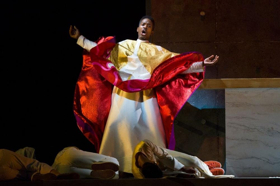Review: Call It Mishmash or MASS, Mostly Mozart Celebrates Bernstein Centennial

MASS. Photo: Richard Termine/Mostly Mozart
This week, Lincoln Center's Mostly Mozart Festival added its two-cents to the Leonard Bernstein centennial festivities, with the first of two performances of Bernstein's MASS: A THEATRE PIECE FOR SINGERS, PLAYS AND DANCERS, in an environmental production by Elkhanah Pulitzer that debuted at the LA Philharmonic in February.
While the rapt audience appeared to be having a swell time, I was less than engaged, and not because of the religious aspects. Whether Bernstein was trying to prove he could do anything--eg, like being a Jew and composing a Mass-related piece--or simply writing a tribute to the Catholic John F. Kennedy, for me it came across as something that was more serious than HAIR and similar musicals of its period but less entertaining.
Nobody's ever pretended that the MASS is Bernstein's masterpiece, though he probably hoped so when it was written a half-century ago. Although he composed it for a significant occasion--the opening of the Kennedy Center in Washington, DC, in 1971--that doesn't mean that the knives weren't out to gut him at its premiere.
Richard Nixon didn't show up (ostensibly to keep the focus on Jackie and the rest of the Kennedy clan) and the FBI's J. Edgar Hoover would have been happy to lead Bernstein out in handcuffs for his left-ish political leanings. (Today, of course, we have a president who probably doesn't even know who Bernstein was.) Unfortunately, the composer did much of the damage himself, trying to be traditional and funky simultaneously: part circus, part musical comedy, part religious rite.

Photo: Richard Termine.
It's no secret that Bernstein longed for the respectability that "serious" music would endow on him--carping critics kept asking him to make up his mind about whether he was a Broadway baby, a conductor or a "serious" musician--but Broadway may have provided his most fruitful outlet. WONDERFUL TOWN, CANDIDE (his music the only enjoyable part of the original), ON THE TOWN (and its ballet predecessor FANCY FREE) and, of course, WEST SIDE STORY, helped make his name--and the echoes of those works can be heard throughout MASS, adding much theatrical flair. (Unlike other composers, Bernstein knew to steal from the best: himself.) Though some of the text is in Latin, Bernstein wrote much of the rest, with the assistance of composer-lyricist Stephen Schwartz and an addition by Paul Simon.
The production from Pulitzer--with Seth Reiser's scenic and lighting design, Laurel Jenkins' choreography, Christine Crook's costumes, Mark Grey's sound and Adam Larsen's projections--made it feel like a "love-in," though I'm not sure that she wandered far from the composer's intentions. In general, it seemed very dated in its presentation, even when Bernstein's music transcended that feeling. Yes, some of the music is gorgeous--and his melding of gospel, jazz, Broadway and religious styles made for a frequently lively hour and 50 minutes--but this was another of those occasions when I thought a piece would be better served as a recording rather than a staged performance.
Despite the size of the piece, there are really only two characters of note.
The Celebrant, baritone Nmon Ford, enters down the aisle from the audience as if he wandered in from a hootenanny. He strummed a guitar and sang, "Sing God a simple song....Make it up as you go along," before taking on his religious garb and becoming leader of the congregants around him in the Mass. (The character would dress down again later in the piece.) Ford used his velvety voice to move back and forth easily in meeting the shifting demands of the work.
The other major role is a boy soprano, sung purely and wisely by Tenzin Gund-Morrow, who comes from one of the participating choruses, the excellent Young People's Chorus of New York City under Elizabeth Nunez. The Concert Chorale of New York under James Bagwell also turned in a fine job in filling the hall with Bernstein's eclectic sound.
The Mostly Mozart Festival Orchestra under its Music Director, Louis Langree, sounded fine, adding much to the proceedings.
Reader Reviews
Videos

